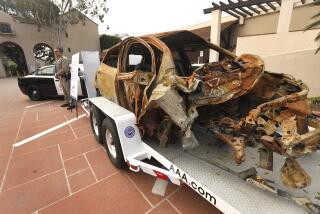Social Attitudes Help Deter Drunk Driving : Comparative Study of the U.S. and Norway Suggests Disapproval Aids Enforcement
- Share via
If you want to become a social pariah, try driving drunk in Norway. On New Year’s Eve or any other time.
In that Scandinavian country--and potentially in the United States--social and moral disapproval may be as important in deterring drunk driving as the tough drunk-driving laws that call for revoking a driver’s license for two years or more and, almost certainly, three weeks in jail for a first offense.
That is the tentative conclusion of a transatlantic comparison by two psychologists at the Claremont Colleges and a Norwegian colleague who are researching in minute detail the imbibing and driving habits of Norwegians and Americans.
Despite the fact that at parties and other social drinking occasions the average Norwegian apparently consumes about 50% more alcohol than the average American, Norwegians seem to be much less likely to get behind the wheel after they’re drunk, the trio report in a series of articles now appearing in professional journals.
In interviews with 1,012 drivers in Norway, and 1,000 drivers in America, the researchers discovered that 98% of Norwegians disapprove of driving after drinking, compared with 79% in the United States. While 79% may seem substantial, the Claremont researchers--who conducted the American part of the survey with support from the National Institute of Justice--said that the remaining 21% represents a significant proportion of the driving population, certainly enough to indicate a serious drunk-driving problem.
In fact, they acknowledge that their research techniques may underestimate the seriousness of drunken driving in this country. In addition, when drivers were asked if they practiced what they preached, the survey revealed that 78% of Norwegians who drove home from a party said they abstained from drinking, compared with 17% of American drivers.
Moreover, the three researchers found that Norwegians were much better informed about their drunk-driving laws. In Norway 95% of drivers knew that blood-alcohol level alone was sufficient for conviction of drunk driving, compared with 46% of Americans, a percentage no better than guessing the answer to the survey question. Seventy-two percent of Norwegians also knew the penalty for a first-offense conviction, compared with 14% of Americans.
What John Snortum, professor at Claremont McKenna College and Dale Berger, professor at Claremont Graduate School, and Ragnar Hauge of Norway’s National Institute for Alcohol Research believe they have discovered flies in the face of conventional wisdom in their field. That viewpoint holds that stricter laws may show dramatic short-term gains in suppressing drunk-driving but the laws tend to have little effect on drinking and driving patterns over the long haul.
In fact, Snortum and Berger said in an interview, other researchers may have given too little credit to social pressure and its effect on law-abiding behavior. Knowledge of the law and certainty that a stiff penalty will be imposed also seem to be important parts of the prevention mix, their research found. Most investigators of drunk driving, Snortum said, tend to track mainly offenders and don’t usually consider the total number of drivers or use other, more comprehensive yardsticks.
For instance, in Norway there is stronger support of stricter laws and random roadside breath testing than in this country. The survey of Americans and Norwegians found that in the U.S. disapproval of drinking and driving depended on personal drinking habits.
About 94% of nondrinkers in the U.S. disapproved of drinking and driving. But the percentage of disapproval dropped to 77% among those who usually consumed one to three drinks at a sitting and to 47% among those drivers who usually have four or more drinks. In Norway, the comparable disapproval rates were 97%, 98% and 98%, respectively. In addition, 89% of Norwegian drivers said their friends would disapprove of them driving after having as many as four beers. In this country, the figure was 63%.
Social Consensus Noted
These last figures reflect what Snortum and Berger believe is the importance of social consensus in diminishing and ultimately controlling drunk driving. Norway’s law--which defines intoxication as a blood-alcohol level of .05% or more, or half the general U.S. standard of .10%--was adopted in 1937 after widespread debate and consideration among the public at large as well as the legislature, Snortum said.
Thus, Snortum argued, social attitudes may make effective laws possible--in large part because the people police themselves.
Snortum and Berger concede that one in three fatally injured Norwegian drivers and one in two fatally injured American drivers had blood-alcohol levels greater than .05%. But they noted that 72,000 randomly obtained blood samples of Norwegian drivers found that only .17% had blood-alcohol levels greater than .05% and that, no matter what the time of week, only about 1% of drivers exceeded the legal alcohol limit. In America, one study cited by the three researchers found that 13.5% of American drivers tested on weekends had blood-alcohol levels greater than .05%.
In their own survey, Snortum and Berger reported that 23% of American drivers admitted to driving “while slightly intoxicated” at least once within the last year compared with 9% of Norwegian drivers. Moreover, 32% of Americans said they had been passengers of an intoxicated driver, compared with 11% of Norwegians.
Snortum and Berger aren’t ready to make an absolute statement about their findings because a host of differences between the United States and Norway, plus a number of uncertainties about their own research, make definitive conclusions difficult, they said.
They also noted that drinking habits are deeply embedded in culture and are difficult to separate entirely from the web of total social behavior.






